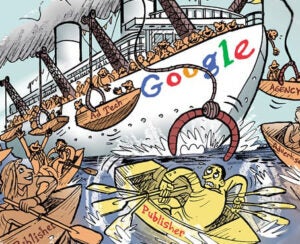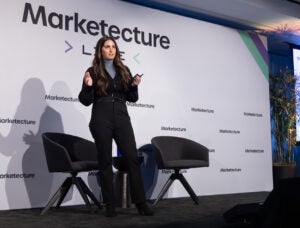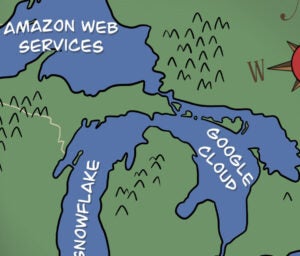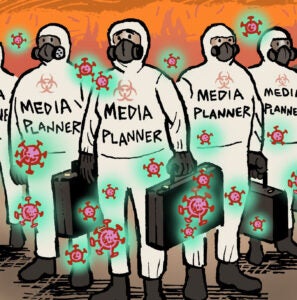 Ted Gurley, a Univision VP specializing in digital sales to political and advocacy groups, compared the current state of the TV industry to retail half a decade ago.
Ted Gurley, a Univision VP specializing in digital sales to political and advocacy groups, compared the current state of the TV industry to retail half a decade ago.
Back then, the existence of brick-and-mortars seemed to be on a precipice as ecommerce companies came to power. But traditional stores surged back by integrating digital into their operations.
Now network executives like Gurley and media strategists from campaigns and Super PACs are adjusting to the kind of digital microtargeting that can be built around TV audiences. (TV still dominates political budgets.) They’re also adjusting to the pricing fluctuations in online exchanges as many well-funded groups enter the pool, willing to spend exorbitantly on targeted inventory.
Borrowing An Audience
Though Gurley only deals with Univision’s digital properties, he said he believes the broadcaster can leverage the audience across its owned and operated channels. The most straightforward method is letting super PACS use its contact pool to send email campaigns.
“Campaigns come with their own voter file-level data, and that includes previous contributions and voting history,” Gurley said. ”Which when you overlay with our audience ends up being a very valuable and precise target.”
But that kind of “audience extension” can be done in more creative, less direct ways, said Univision’s EVP and GM of digital, Mark Lopez. For instance, Univision’s breadth of programming – sports, soap operas, reality shows, radio programs, music events, etc. – means advocacy groups can find their political audience outside of Univision News, which is a separate entity within the business.
Though TV is less attributable and precise, political campaigns are moving toward the holistic funnel approach favored in the private sector, according to Chris Talbot, who was on Google’s political and advocacy team before opening his own liberal digital strategy shop.
But most political advertisers haven’t reached that level of sophistication, Talbot said.
“What people are working toward is having the 30-second TV clip,” he said. “Supplement that with shorter, pre-roll videos, as well as longer content that goes into more depth, with social outreach around all of that.”
According to strategists and political ad sales leaders, it’s a huge benefit to be able to shepherd viewers down that chain. Political entities will try to push viewers from TV to whichever channel is optimal depending on their goal (persuading voters, raising money, developing email and volunteers or getting out the vote). It’s the same idea of a customer journey, but applied to politics, where “lifetime value” is small consolation to the teams that don’t convert on Election Day.
Which is why, when it comes to reaching the tiny pool of genuinely up-for-grabs voters who live in swing states, the digital ecosystem is prepping for CPMs that wouldn’t make sense if the market weren’t suddenly saturated with political interests.
The Inventory Dilemma
Political ad buyers are concerned that inventory will be limited for reaching a highly target demo during peak political periods.
“It will be impossible for anyone to deliver the same Iowa voters for 17 Republican candidates and 35 super PACs at scale,” said Peter Pasi, a GOP strategist and VP of political sales at the ad network Collective.
Univision has developed advertising opportunities that address that issue by going beyond typical display and introducing other ways to sustain inventory. Lopez pointed to Snapchat campaigns or additional YouTube programming that is tied to popular shows as examples of “strong potential advertising products for us.”
These channels create new inventory for broadcasters, and new buying opportunities for advertisers.
But for truly limited opportunities, like page takeovers or customized campaigns at crucial moments (like a debate, caucus or primary), Univision is content to let the market sort it out.
Raw supply can’t make up for the fact that political groups have structurally different incentives and financial restraints (money raised must be spent).
“What we have seen in past cycles – and what we will see again – is CPMs at four to six times the market rate,” Pasi said.
Talbot said political groups are not pre-buying certain inventory – “pre-roll video, especially for key audiences or in certain areas” – because they’re concerned the real estate won’t be there. They’re just accounting for expected price increases of at least 300-400%.
Those price fluctuations won’t drastically shake up the digital advertising landscape. The billions generated by political advertising are “high-profile,” Talbot said, “but a sideshow in advertising’s total revenue.” The infusion of political dollars is the rough equivalent of adding another marketer on the scale of P&G or Unilever, which is nothing to scoff at but easy enough for the industry to digest.
Pasi emphasized that many media brands are well placed to extract steep tolls from political groups because they’ll have access to individuals with high, ongoing value to an array of ad buyers. “Campaigns will pay inflated – and in many cases unprecedented – prices for these ads.”













